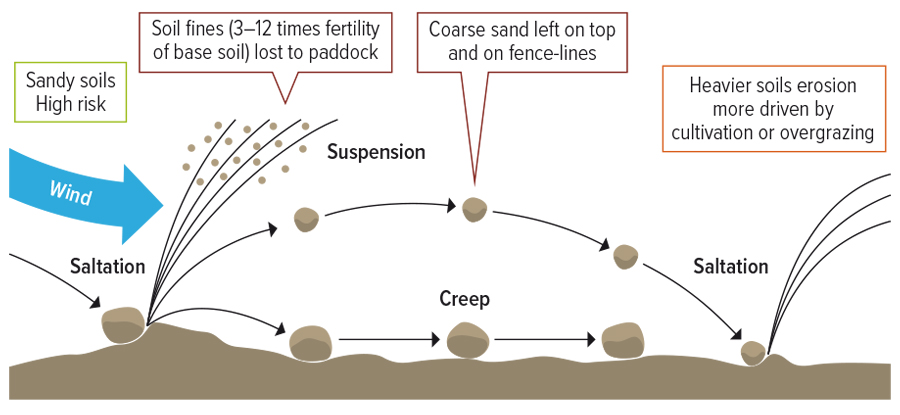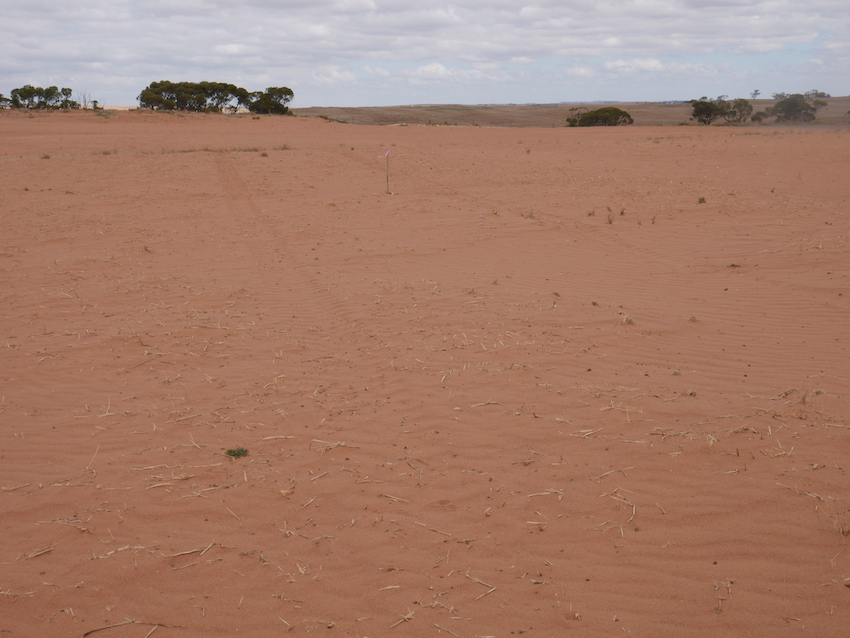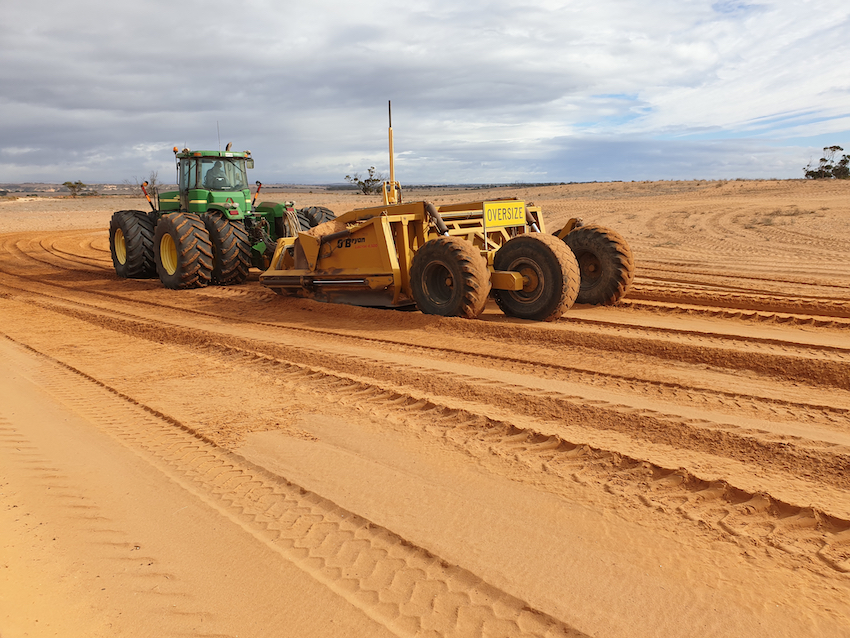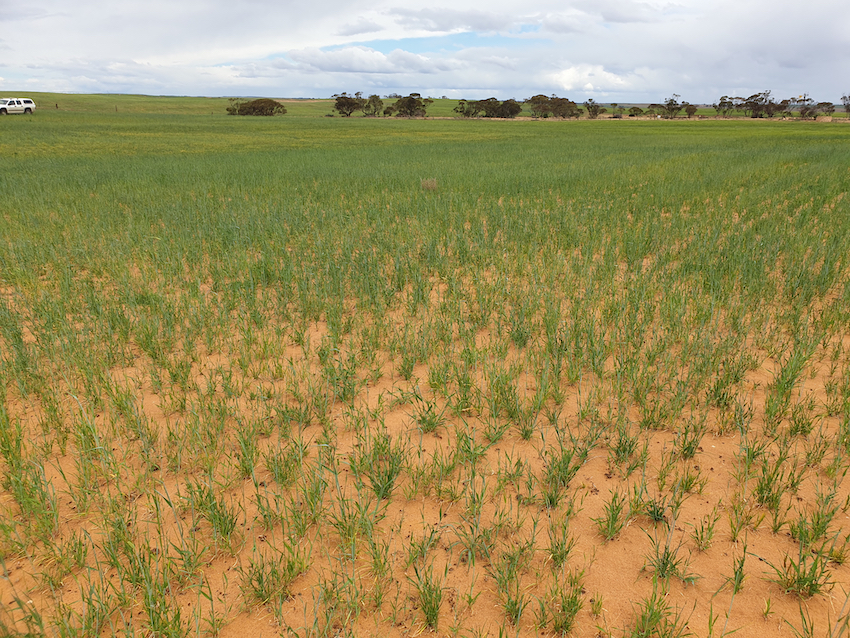By helping to bind soils together, no-till farming systems help to mitigate erosion risks in ways that boost a farm’s sustainability (see Figure 1). These benefits are especially valuable given the tendency of Australia’s climate to cycle between extremes of drought and floods.
Maintaining groundcover during these extremes, however, can be challenging. Yet, such seasons have provided growers with a living laboratory in which to watch, learn and test methods to protect groundcover until the rain arrives (or the floods recede).
Figure 1: Wind erosion processes.

To capture, curate and disseminate these on-farm lessons, GRDC invested in the production of a series of on-farm wind erosion case studies. These convey practical tactics to both protect a farm from soil degradation during successive years of drought and rehabilitate the land back into production if blowouts occur.
In all, eight case studies (covering 32 paddock monitoring sites) were produced and can be viewed on the GRDC website.
The study sites were based in the low-rainfall zones of the southern region, including the Victorian and NSW Mallee and the Eyre Peninsula, which were affected by successive dry years in 2018 and 2019.
A key message that emerged from these studies is the need to maintain at least 50 per cent anchored soil cover. Dropping below 20 per cent makes soils extremely vulnerable during dry years.
Maintaining this level of cover requires vigilance and a proactive approach. Annual monitoring of groundcover levels and stored moisture is recommended in August/September and again in autumn. These assessments then drive a strategic management decision between three options:
- continue the normal management plan;
- stabilisation: take strategic decisions to protect vulnerable soils and minimise risks; or
- full reclamation: soil levelling and sand amelioration.
Proactive management of vulnerable zones within paddocks is possible and can prevent large rehabilitation costs and long-term production losses. For example, sandy zones should be fixed with delving, clay spreading, spading and so on.
Additional tactics then depend on the nature of the farming system.
For continuous croppers
- Pay attention to existing cover levels, particularly with late breaks and low stored moisture levels. Satellite technology can now assist with monitoring.
- Maintain soil organic matter, clay fines and soil fertility.
- Watch your wheel tracks and other trigger points for blowouts and resow where needed.
For mixed farmers
- Identify the paddocks with the least vulnerable soils and target these for more summer and autumn grazing.
- Sowing summer crops late in the season can provide safe, productive summer and autumn grazing.
- Take a proactive approach to confinement feeding and feedlotting rather than using them when it is too late.
Snapshot of case study 3
At Walker Flat in SA, Phil, Yvonne, Aaron and Liz Haby farm 4000 hectares. They maintain 1000 breeding ewes and cultivate cereals and legumes on about 3000ha using no-till on their erosion-prone sandy soils.
In 2020, a large blowout area quickly got out of control after a heavy traffic strip was further exacerbated by the combined effects of sheep camping around a trough area, low rainfall and strong winds (Photo 1). Despite a late season break and minimal rainfall throughout the year, the Habys were confident they would still achieve adequate groundcover to rehabilitate the site.

Photo 1: Eroded site in March 2021 before levelling. Photo: Dr Chris McDonough, IEA
The Habys used their 4.5-metre-wide O’Brien Laser Bucket (that holds about 25 tonnes when full) to drag, shift and level the blowout sand area (Photo 2). They pulled it with a 425HP dual-wheeled articulated tractor. They cut through the centre of the blowout area to establish an even grade line, filling in holes, knocking down ridges and then working each side to level the area. The first levelling operation brought plenty of moist sand to the surface (due to soil being essentially fallowed since mid-2020) and this moisture assisted in crop establishment.

Photo 2: Using the O’Brien Laser Bucket to shift sand and level the soil. Photo: Dr Chris McDonough, IEA
The area then had 10t/ha of chicken manure spread over the surface. The site developed a crusty surface layer that protected the sand from blowing during the early crop establishment phase. The surface sand dry aggregation (DA) measured a very low 5 per cent in March 2021. After levelling, spreading manure and seeding, this site showed a safe 35 per cent DA by December of the same year.

Photo 3: Cross-sown crop growth in early October 2021, with adequate soil coverage despite poor season. Photo: Dr Chris McDonough, IEA
The area was sown to barley but the crop suffered erosion damage and was cross-sown using a disc seeder with Vampire (PBR) cereal rye to maximise soil coverage. The cereal rye established well after good July rains and continued to grow, producing adequate biomass (Photo 3) and providing sufficient soil cover through the following summer, with no erosion (Photo 4) despite only 130 millimetres of growing-season rainfall. This strategy helped the Habys to maintain more than 50 per cent soil cover from December 2021 to May 2022 at this site.

Photo 4: December 2021 showing adequate soil cover during summer. Photo: Dr Chris McDonough, IEA
No grazing on the rehabilitated area will be undertaken in the foreseeable future and the traffic lane has been diverted to a different route.
In 2022, the area was resown to another cereal to establish a strong root base in the topsoil, which resulted in a well-anchored standing stubble for the second year in a row. The Habys are now confident this paddock will support a productive cropping rotation, including a legume, into the future.
Case studies
Case study 1: Introduction – Practical tactics to improve groundcover and ensure soil preservation following successive low-rainfall seasons.
Case study 2: Proactive soil cover strategies within sustainable continuous cropping programs – including pulses. Features grower Robin Schaefer from Bulla Burra, Loxton, SA.
Case study 3: Repairing severe blowouts at Walker Flat in decile 1 season. Features growers the Habys from Walker Flat, SA.
Case study 4: Re-levelling blowout areas for effective seeding and harvest. Features growers the Habys from Walker Flat, SA.
Case study 5: Changing sand mechanically and biologically to support drought resilience. Features grower Ben Ranford from Cleve, SA.
Case study 6: Cropping land restoration and the lessons following successive years of drought in NSW. Features grower Nigel Baird from Wentworth, NSW Mallee.
Case study 7: Rules of thumb for optimal cropping paddock management. Features grower Ben Pollard from Wentworth, NSW Mallee.
Case study 8: Livestock management strategies safeguarding against wind erosion. Features grower Ed, Carolyn, Evan and Lauren Hunt from the Eyre Peninsula, SA.
View the case studies in full.
More information: Tanja Morgan, tanja.morgan@msfp.org.au; Chris McDonough, cmcd.insight@gmail.com

























































